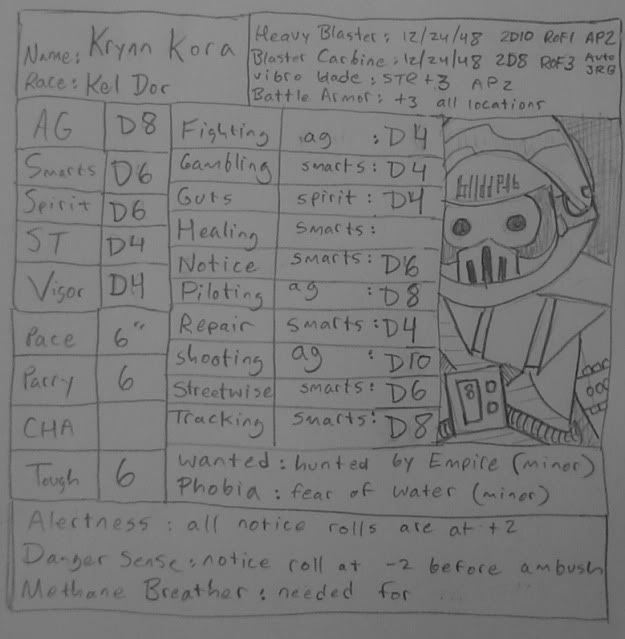
As promised from my last RPG post, pitting disgruntled Star Wars rebels whooping up on some deserving Imperial scum, here's a little more in-depth look at the rules we used, and not necessarily the game we played itself. Savage Worlds is one of those games that has garnered good reviews and a positive following over the years. A newer edition (Explorer's Edition) has emerged which is said to have fixed some minor issues, tweaked others, and overall fine tuned what was already am award-winning RPG engine.
Savage Worlds is set up as a generic system tailored to meet whatever genre demands the players require. To help it along in defining certain areas to game in, companion rulesets are out there to cover the weird west Deadlands, sci-fi future, weird war two (so hot right now), pirates, and even the New World (among many others). There's a fantasy companion as well. The best part is, the core rules themselves are just $9.99, in full color!

Character creation was incredibly fast and easy. The above, handwritten sheet was for the Star Wars game we did, and took up, maybe, a fourth of the page. It's very self-explanatory, and the fact that different dice are used to represent your skills is easy and intuitive for someone new to the system. The higher your die type, the better you are at that attribute. Using above Krynn Kora as an example, his dexterity is fairly high at d8, and both smarts (intelligence) and spirit are decent enough at d6. As you can see, vigor (overall health) isn't that great at d4. Your die types are bought with points, so there's only so much you can bump up, and the higher one stat becomes, the lower another conversely becomes.
Skills are handled with a points buying system as well, and the skills tie directly into your attributes. With the above example, I took 'gambling' as a skill, which is tied to the attribute smarts (d6). I could go as high as d6 (my attribute) with the gambling skill if I wanted easily enough. I just wanted to have the skill though, not necessarily be great at it, so I just bought it to have it on paper at its lowest value. Using skills untrained altogether is a much tougher prospect to succeed with. If you look at 'shooting', tied in with my dexterity (d8), the skill is higher than the attribute. I was able to buy it up to my max attribute of d8 no problem, but to go beyond that I had to pay double for each level of progression. This system works well to favor skills that are tied in with your natural attribute strengths, but allows flexibility enough to give a character with a low attribute to still have a high skill related to that attribute. Such as the high smarts technician still having a decent fight (agility).
You'll find that you don't quite have enough points to really make your character the exact way you want, so you can pick up hindrances. Hindrances come in two varieties; minor and major. Depending on what you take, you'll get more points to use towards both skills and starting attributes. For me I took two minor ones; "wanted" and "phobia". These were fairly generic, and the rulebook offered many, many hindrances to choose from. There are also benefits called edges you can choose from too, however these cost points, but give neat stuff.
Gameplay proceeds as pretty much any regular RPG, with an exception being in initiative "rolls" which uses a standard deck of cards instead of dice. It was a neat change of pace, but I didn't feel it was necessary. Also you get 'bennies' for each character, we used poker chips. These work in the same manner as action points and/or re-rolls. The rest of the game goes along the same lines, and puts the action squarely in the hands of the players. Because of the intuitive and light nature of the rules, it seems that there should be less prep time on the part of the GM's, with more time spent on story and less on stat crunching. Also, even with brand new players, you can focus on gameplay, and worry less about rules.
I only played the one game (so far) and it was set up as a one-shot adventure as well. Though, having never even seen the Savage Worlds rulebook in person before, I basically didn't miss a beat. Character creation was easy to grasp and make whatever you wanted to, and flexible enough where we had three entirely different characters at the table in short order. The rules didn't feel limiting at all, and I didn't feel like I was constrained by them throughout the game. As my character interacted with the story and made decisions, everything just flowed together and made for an enjoyable and less complicated romp than other systems.
Nice write-up. Thanks for the info. If you do anymore Savage Worlds games please feel free to post about them.
ReplyDeleteThanks again!
Thanks for sticking around!
ReplyDeleteOur plate is so overstuffingly full right now, hopefully though we'll return to Savage Worlds, either to continue our SW one-shot, or for something else. I definitely write it up!
Excellent Mik. An overstuffingly full gaming plate sounds awesome!
ReplyDeleteLooking forward to your next write-ups!